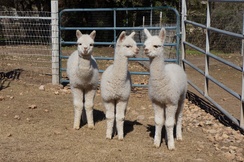Monday, January 14, 2013
More about Alpacas

Alpacas: Part 2 in the Series
Raising alpacas and using their fiber continues to be a growing industry in the United States although the growth has been slowed by the economy, pretty much like everything else. Unlike many other livestock industries that have completely collapsed, the alpaca industry continues its gradual growth because of the intrinsic value of alpacas as livestock and of their fleeces. One good side of these economic times is that alpacas have become much more affordable and buyers can be choosy.
Alpacas are generally easy to raise. Most owners had little, if any, experience with livestock before starting their herd. Alpacas will generally integrate well with other livestock, including goats, donkeys, and horses. Some breeds of domestic dogs are very suitable for alpaca, although a dog that gets inspired to “hunt” may get cornered by the herd, which could end up badly for the dog. Alpaca ranchers appreciate the intelligent and inquisitive nature of alpacas as well as their modest consumption of hay and feed. Their padded feet do not dislodge the fragile Hill Country soil, and the lack of upper teeth means they do not destroy the roots of native grasses. Owners also appreciate their tendency to have babies (cria) at convenient daylight hours, probably a survival throwback to the thousands of years of having cria in the Andes where it is best to be born at a warm time of day. The mothers (dams) have one cria per year and our Texas heat makes winter crias a better idea. Indeed, the Texas heat is a special consideration with alpacas as they are Andean animals. Alpacas do thrive in Central Texas with protection from predators, provision of forage, water, and shade, and with timely early shearing to keep the fleece short in the summer months. Alpacas do not need much space, which is perfect for people with small acreage. They do tend to use one spot in the pasture as a community toilet, which is convenient for pasture clean up. Of course, they will choose where that particular spot is, and sometimes it’s not where the humans want it to be. Come the next spring, that spot is the greenest place in the pasture.
Alpacas are gregarious herd animals whose greatest stress is being isolated from other alpacas, even by just a fence. They always need an alpaca “friend”. More on that with the next installment.